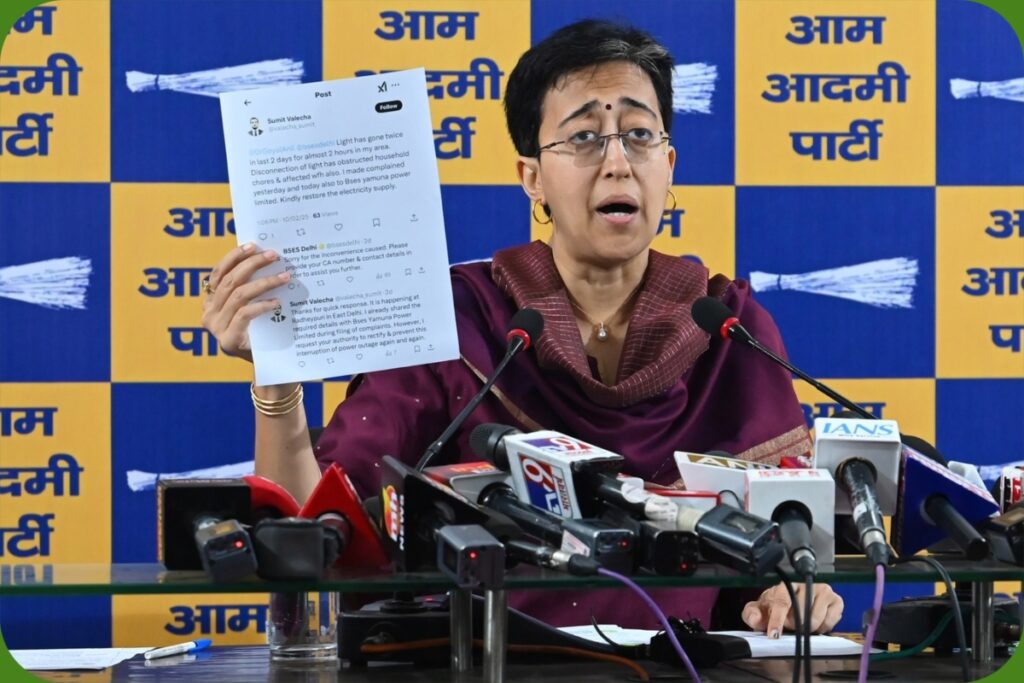In the blistering heat of April 2025, Delhi’s residents are struggling—not just with rising temperatures but with hours-long power cuts that have thrown daily life into disarray. On Sunday, Delhi Minister Atishi strongly criticized the BJP’s much-touted “double-engine” government, claiming it has “failed to provide basic electricity to the people.” Her sharp statement comes amid widespread public frustration over power shortages.
Power Cuts in the Capital: What’s Happening?
Over the past few days, multiple areas in Delhi have reported power outages lasting several hours at a stretch. From residential neighborhoods to commercial zones, the lack of electricity is disrupting lives, businesses, and even essential services like hospitals and metro stations.
Citizens have taken to social media to share their grievances, using hashtags like #DelhiPowerCrisis and #ElectricityFail, calling for accountability and urgent action.
Atishi Blames the BJP: A “Double-Engine” Failure?
Speaking to the press, Delhi’s Power and PWD Minister Atishi didn’t mince words. She slammed the BJP’s central and state leadership, stating:
“This is the reality of BJP’s ‘double-engine’ government. Despite controlling both the Centre and the state in many regions, they have failed to provide even the most basic facility—electricity.”
The term “double-engine government” has often been used by BJP to imply that when both the central and state governments are under BJP rule, development accelerates. However, Atishi argues that Delhi’s current crisis is proof that the model is failing in real time.
Also check:- A New Era Begins: PM Modi Inaugurates India’s First Vertical Lift Sea Bridge in Rameswaram
What is the “Double-Engine” Model?
The BJP often promotes the double-engine model to project seamless coordination between Centre and state. The idea is that such synergy can fast-track infrastructure, governance, and public welfare projects. But critics argue that it sometimes leads to blame-shifting rather than actual performance.
Atishi’s comments tap directly into this criticism, highlighting how even with BJP’s influence, citizens are bearing the brunt of poor management.
Delhi’s Demand vs. Supply: What’s the Gap?
Electricity demand in Delhi has spiked due to the heatwave, with consumption crossing 7,000 MW in recent days. However, experts believe that lack of adequate power purchase agreements, aging infrastructure, and mismanagement are leading to supply bottlenecks.
Atishi stated that power generating companies were not supplied with enough coal, directly hitting generation levels. She added that transmission failures and poor maintenance further worsened the situation.
Opposition leaders and civil society groups have rallied behind the public outrage. Many see this crisis as a reflection of larger governance issues, especially in urban infrastructure planning.
The AAP-led Delhi government has demanded immediate intervention from the Centre, while BJP leaders have attempted to deflect the blame, claiming that technical faults and weather conditions are behind the power shortages.
Meanwhile, affected residents are less interested in the blame game and more concerned about when their fans, air conditioners, and fridges will work again.
Heatwave + Power Cuts = Dangerous Mix
Delhi is currently facing temperatures above 43°C, making these power cuts not just uncomfortable but dangerous. Vulnerable populations such as the elderly, children, and patients are especially at risk.
In hospitals, managing critical equipment without steady power becomes a massive challenge. Even water supply is getting affected due to stalled pumping stations.
Stay tuned to get more updates on political news!


